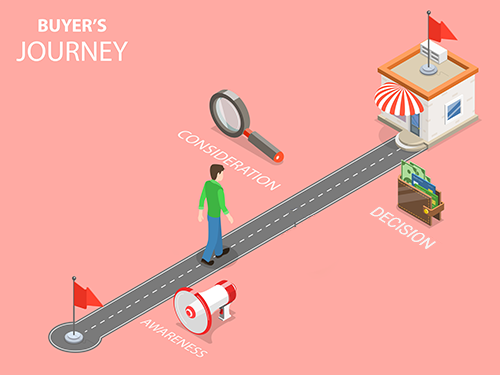Selling should generate revenue, lots and lots of revenue.
But if you’re like most companies, you will continue to be unknowingly robbed by a world-class saboteur: yourself.
Selling doesn’t have to be hit-or-miss.
However, by updating your sales practices, you can seriously amp up your close rate and quit robbing yourself of revenue.
Here are the 6 most popular sales mistakes we’ve seen business make as a marketing agency and through our fractional CMO services that take the OOMPH out of their sales and keep the money out of their pocket.

How are your sales efforts contributing to your company’s growth?
Schedule a brief discovery call to receive a complimentary consultation for your business.
#1 You’re Not Tracking the Buyer’s Journey
Buyers don’t need ads or sales reps anymore to discover what’s out there.
A quick Google search will pull up hundreds of results on what their problems might be, how to solve them, and all the options they have. Lead generation takes place online before potential customers even consider reaching out to a sales team.
That’s why effective selling doesn’t mean telling people what to do. Instead, your salespeople should act as advisors that help your leads make sense of all the information that’s out there.
And being a good advisor starts with knowing what your leads need and when. Understanding the buyer’s journey is a crucial part of that.
What is the buyer’s journey?
The buyer’s journey is the process a lead goes through to go from being completely unaware to deciding to buy.

It consists of:
- The awareness stage: Someone realizes they have a problem and starts looking up information to understand what’s going on.
- The consideration stage: Someone starts searching for a solution to see what’s out there price-wise, feature-wise, etc.
- The decision stage: Someone goes into full-blown decision-making mode by narrowing down their list of options, weighing pros and cons, to finally make the purchase.

Why Tracking the Buyer’s journey is Your Ticket to More Sales
By understanding the buyer’s journey, you will:
- Know what to say when to move your lead down the pipeline.
Imagine I am a lead. If I’m just figuring out whether I have a problem, I don’t need to hear all about your product specs. However, if I am looking to make a final decision, you don’t have to educate me anymore about what my issue is. - Create the right content to move leads along at each stage.
When you know what your lead needs to hear you can prep materials that will help your sales reps say exactly the right thing at the right time. - Avoid making leads feel pressured into buying.
By being sensitive to what leads are looking for, you’ll avoid overwhelming them with information and feel like they’re being sold to. - Reduce friction along the buyer’s journey and create a consistent brand experience.
Building trust is incredibly important. And to do so, you need to make sure that the message you’re sending out is the same, all across the buyer’s journey. - Identify where in your sales funnel leads are dropping out and fix it.
Tracking the buyer’s journey will also help you figure out what channels work best for reach-out, and what messages make your leads say yes.
Newsletter Sign up!
Get our best content on digital marketing in your inbox 2 times a month

How to Start Tracking and Optimizing the Buyer’s Journey
To start getting an overview of the buyer’s journey of your target audience, take the following steps:
- Map out the different stages of the buyer’s journey.
Describe what your leads are thinking, feeling, and doing at each part of the journey. If they are starting to become aware of their problem, what terms might they search for to understand it better? If they’re looking for a solution, what social media platforms might they check out? - Start putting processes and systems in place to track the buyer’s journey.
Determine what metrics signify success at every stage, and keep re-calibrating your buyer’s journey depending on the insights you gather.
Done with reading articles like these to figure out why your sales team isn’t selling?
Schedule a free 30-minute consultation with us to find out how you can 2x your revenue and make people wonder what sales superstar you just hired!
#2 You Don’t Have a Sales Process in Place
All too often we see sales teams where everyone has wildly different ways of working.
Everyone is using their own tools for reaching out. Details are scribbled down in notebooks or not at all. And if you’d see their sales rep’s messages, you might think they’re talking about entirely different products.
But, without a unified way of working, you can’t track and improve your performance. You also risk creating an inconsistent brand and customer experience, and you are more likely to have human errors creep in.
That’s why the best companies have a sales process to streamline their working methods across the sales department.
What is a Sales Process?
A sales process is a set of documented steps for converting a lead into a customer, all the way from early stage to closed deal. By implementing a sales process, you’re providing your sales team with a guide that helps them take the right steps at the right time.
Why You Should Have a Sales Process
According to a study conducted by Vantage Point Performance and the Sales Management Association, there was a difference of 18% in revenue growth between the companies who did define a formal sales process and the ones who didn’t.

And that’s because a sales process helps you:
- Generate more revenue by providing sales reps with an efficient and tested roadmap to closing deals.
- Track how you’re doing and make systemic improvements where they matter most.
- Get new sales reps quickly up to speed on your work processes and become productive members of the team.
- Relieve your sales manager from shouldering all the coordination and training tasks, freeing him up to work on higher-level tasks.
How to Start Implementing a Sales Process
If you’re ready to start putting a sales process in place, here are the steps to take:
- Understand your customer.
What are their goals, wishes, problems, and concerns? What are their main objections when considering buying your solution? Customer research (buyer interviews, surveys) and interviewing your sales reps can help you uncover these things. - Determine the phases in your sales process and milestones.
What events indicate your lead has moved to the next stage of the buyer’s journey? Which milestones can you identify? What are the common mistakes and how can your team avoid these? Pay special attention to hand-offs between sales reps. - Define the success metrics at each phase of your sales process and make an action plan to measure these.
- Create standardized scripts to streamline the frameworks and messaging your sales reps use.
~Note: This does not mean all your sales reps should say the same exact things. Don’t make your sales team sound like an army of robots! Give general guidelines, but leave enough room for your sales reps to work their magic.~
- Collect materials that’ll help your sales team be successful at each stage of the sales process.
This can include:- case studies
- blog posts (see 5 Reasons Why You Should Blog for Your Business in 2021)
- product demonstrations
- videos
- training for your team on particular topics.
Newsletter Sign up!
Get our best content on digital marketing in your inbox 2 times a month

Make sure they’re easily accessible for everyone by having a “one source of truth” document.
- Get in touch with your sales team to find out how they work.
In this way, you can shape your process to fit their existing habits and make it as easy as possible for them to follow it. - Democratize your metrics by showing important statistics across the entire buyer’s journey.
It’ll give your sales team an easy way to see how they’re doing and make improvements. - After implementing, keep tracking and gathering feedback on how it goes.
Like with everything, the best sales processes are the result of a lot of experimenting and adjusting.
#3 You Have a Sales Process But it’s Poorly Organized
A sales process that’s poorly designed or badly implemented can be worse than having no sales process at all.
Here are the ways in which your sales process could sabotage your efforts to gain more customers:
- Your sales process doesn’t suit the work style of your team.
Costing them more time and energy than it saves them — they could be spending that time talking to more leads! - Your sales process is too rigid.
Hindering your sales rep’s ability to focus on the lead and their needs, rather than the needs of your sales process. - Your sales process feels pushy towards the lead.
Don’t make the mistake to start prioritizing efficiency above empathy: the lead will definitely notice it!
How to start fixing your sales process
Are you realizing your sales process could use a good update? Here are the next steps to take to start making your sales process the power tool it can be:
- Find out where it goes wrong by analyzing your current sales process.
What actions are involved? Where are leads getting lost? Who’s involved? How well is your sales team following your process? Go to your sales reps and ask them all about it, like what they spend most of their time and energy on or where in the process they’re missing guidance. Observe them while they’re doing their work and are going through the sales process. Map out a few deals from the very start to closing. What did the sales rep do during each stage of the sales process? How long did every stage take? - Map out the buyer’s journey.
What do leads care about at each stage? What’s important for them to take the next step? What are the concerns that keep them from doing so? How is your sales process helping or hindering them in this? - Determine the action that’s most likely to move them to the next stage.
Do they need validation of their problems? Do they need to be convinced you’re an authority? Do you need to reassure them by countering their objections and fears? - Leave room for flexibility so your sales reps can adapt to the lead’s needs.
- Test, improve, and repeat.
Building a great sales process should remain an iterative process you keep working on to make it better and better.
Make sure to not blindly copy-paste a process from another company without modifying it. Every company is different, and to get the best results you have to optimize the sales process for your organization.

- Free Sales Downloadable
#WinMoreSales Sales Tips Sheet
Get quick, actionable tips on how to increase your sales win ratio.
Free Download
Just fill out the form below and we’ll send you a FREE copy of our #WinMoreSales sales tips sheet!
#4 You Haven’t Properly Onboarded your Team onto your Processes and Tools
Just a great sales process won’t do the trick – you also need to make sure your team can execute on it.
That’s why another common sales mistake is failing to give your team the onboarding it needs to start using your processes and tools. This is more commonly referred to as sales enablement, and developing a strategy helps align your marketing and sales teams to grow your business.
How to Properly Train and Onboard your Team onto your Processes and Tools
- Involve sales teams from the get-go when creating your sales process and/or implementing new systems. This will help you adapt these to their current way of working, familiarize your team with the changes, and help them embrace these.
- Explain why you’re making the change. Remember that changing any habit is difficult – resistance is a real thing! So with any change, clearly explain why you’re doing it and how it’s going to benefit the company.
- Onboard new employees onto your processes and tools as soon as they join the team.
- Provide plenty of easily accessible training tools and documentation. Including guides, video tutorials, and appointed team members can turn to, in case they have questions.
- Keep gathering and implementing feedback. So you can add or improve on any items that are missing or unclear. Make it easy for your team to give feedback!

#5 You’re Not Using Metrics to Improve your Sales Process
We don’t have to rely anymore on the “spray-and-pray” approach – we can start tracking metrics to see what actually works, and what doesn’t.
Yet, we see too many companies who still leave their sales performance up to chance. While tracking metrics consistently will help you:
- Identify the most promising sales techniques
- Adjust the actions of your sales team and help them make better decisions
- Identify the leads that are most likely to convert
- Pinpoint the small actions in your funnel that can make all the difference (micro-conversions)
- Know where to put your focus
- Discover what channels work best for your product
- Forecast how many sales you’re going to close from a given number of leads
- Set realistic quotas
- Discover the root cause of leads getting stuck in your pipeline or falling out
Newsletter Sign up!
Get our best content on digital marketing in your inbox 2 times a month

Want to know what metrics to start measuring at your organization? Check out this article by Hubspot to discover more sales metrics than you know what to do with.
How to make data your competitive advantage
Now that you (hopefully) know that tracking your metrics is the way to go, here are the next steps to put your new-found wisdom into action:
- Avoid information overload by determining what metrics you want to focus on. Take a look at your KPI’s, objectives, and targets, and determine what metrics will most accurately measure success.
- Start putting systems in place to measure metrics across the entire buyer’s journey. To do this, you need to aggregate all your data in one place. Hint: that’s why CRMs are so valuable to sales teams!
- Use the power of automation and pre-filled fields to minimize the chances of incorrect or duplicate data ending up in your database. If done well, it’ll also help your sales reps save heaps of time. But you have to make sure that you’re not making your system SO rigid that it disrupts your sales team’s natural way of working.
Overwhelmed by how to use a CRM and tracking software? Contact us for a free 30-minute consultation to find out how to make data your competitive advantage.
#6 Your Sales and Marketing Teams Work in Silos
Your sales and marketing teams both have the same goal, right? Getting you more customers, revenue, and growth.
Then why are they so often working in silos and barely communicating with each other? We’ve seen this countless times: inconsistent messaging along the buyer’s journey that hurts your brand image, leads falling through the cracks as they’re being handed over from one department to the other, and both departments blaming the other for the loss of the sale.
And hear this: according to Hubspot, not having your sales and marketing department aligned well can cost businesses a staggering $1 trillion a year.
With a proper sales enablement plan, you’ll start to see the dramatic benefits of having marketing and sales acting like one team.
- Sales can identify promising leads and feed this back to the marketing department, so they can adjust their marketing strategies to bring in more qualified leads.
- Marketing can give sales teams information about the messages used so sales teams can latch onto those and provide a seamless customer experience.
- The marketing team can provide the sales team with all the juicy stuff they need to “wow” leads, including presentations, pitch decks, videos, demonstrations, articles, whitepapers, and other types of content.
- The sales team can notify the marketing team of the challenges they heard their leads talk about and what messages resonated with them. This will help them to vastly improve the effectiveness of their ads and content marketing.
How to turn your sales and marketing teams into a revenue powerhouse
Here are the next steps to take to transform your sales and marketing departments into one badass revenue team:
- Set mutually agreed-on written goals across the marketing and sales department. In this way, both departments are on the same page on what needs to be achieved, what’s most important, and can join forces to achieve those goals.
- Map out the customer journey from unaware to a closed deal. This will help your teams get the full scope of what they’re doing and think beyond their own department. It’ll also help you identify at what stages collaborating is key to making a lead convert.
- Implement systems and processes to track metrics across the buyer’s journey. Do this by unifying the systems used across the sales and marketing departments.
- Make it easy to share information between the departments. By providing a shared way of communicating, and sharing systems and folders across the board.
- Celebrate wins jointly. If the sales team wins, everyone wins! The same counts for marketing of course. Reminding everyone of the fact that we’re all working towards the same goals.
As you can see, there are many ways in which we can sabotage our ability to run a profit, but also many ways in which to improve.
The big takeaway is to put your future customer at the heart of what you’re doing. Figure out what motivates them to buy and structure your sales (and marketing!) efforts around that.
Remove Common Sales Mistakes With Ellison Ellery
At Ellison Ellery we have years of experience removing friction in the buyer’s journey and helping businesses eliminate challenges that are preventing their growth. We understand the difficulty of getting every team aligned on strategy and the frustrations that come with a lack of consistency across the board.
We’ll become the marketing executive your business needs to close those gaps and start seeing progress.
Temporary fixes aren’t going to be enough—schedule a quick consultation with us to start making real, targeted change to bring in more sales!

How are your sales efforts contributing to your company’s growth?
Schedule a brief discovery call to receive a complimentary consultation for your business.






